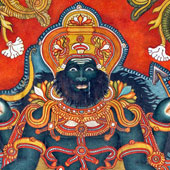Design Resource
Kerala Murals
The Art of Painting on Walls
by
Prof. Bibhudutta Baral and Antony William
The wall is prepared for painting and the images are sketched out free-hand using cow dung ash mixed with coconut water or water. The outlines were originally done with cow dung pencils, called Kittalekhini.The shading is adeptly colourized by symbolizing the characteristics separately for each god. The colours are indigenously obtained from the extracts of the leaves, roots, earth and stones. The colours are generally painted beginning with the lighter colours.The order of colouring is firstly yellow, red, green, blue and brown (mixed red and yellow). White is by no means used, except for the prevailing white spaces which are retained during the initial coating. On shading, black is used to delineate and bring life to the portrayal. The painting is over-coated with pine resin and oil for sheen and protection. The five fundamental colours used for painting of murals are prepared from mineral pigments and vegetables like leaves, fruits, stones and ores.
• Green is obtained from the extracts of a local plant called Eravikkaraor from mixed dried and powdered red leaves of Neela Amari (Indigofera) (blue in colour) and Eruvikkara leaves (yellow in colour) are used in different proportions for shades of green.
• Black, from the soot of the sesame oil which is collected inside a mud pot or burnt husk.
• Yellow is obtained from turmeric powder or from fine ground laterite stones which is used for yellow and red, which is filtered and dried.
• Red from the minerals like a mixture of lime and turmeric powder.
• White is obtained from lime.
The colours are blended in a wooden bowl along with tender coconut water and extracts of Neemtree.








